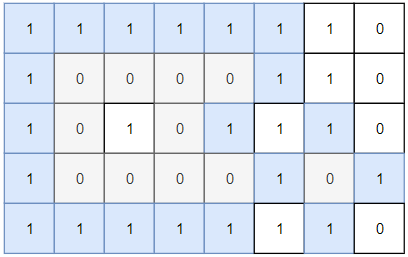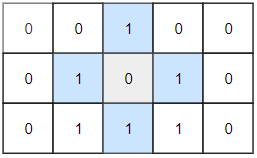Given the following details of a matrix with n columns and 2 rows :
- The matrix is a binary matrix, which means each element in the matrix can be
0or1. - The sum of elements of the 0-th(upper) row is given as
upper. - The sum of elements of the 1-st(lower) row is given as
lower. - The sum of elements in the i-th column(0-indexed) is
colsum[i], wherecolsumis given as an integer array with lengthn.
Your task is to reconstruct the matrix with upper, lower and colsum.
Return it as a 2-D integer array.
If there are more than one valid solution, any of them will be accepted.
If no valid solution exists, return an empty 2-D array.
Example 1:
Input: upper = 2, lower = 1, colsum = [1,1,1] Output: [[1,1,0],[0,0,1]] Explanation: [[1,0,1],[0,1,0]], and [[0,1,1],[1,0,0]] are also correct answers.
Example 2:
Input: upper = 2, lower = 3, colsum = [2,2,1,1] Output: []
Example 3:
Input: upper = 5, lower = 5, colsum = [2,1,2,0,1,0,1,2,0,1] Output: [[1,1,1,0,1,0,0,1,0,0],[1,0,1,0,0,0,1,1,0,1]]
Constraints:
1 <= colsum.length <= 10^50 <= upper, lower <= colsum.length0 <= colsum[i] <= 2
Solution: Greedy?
Two passes:
first pass, only process sum = 2, upper = 1, lower = 1
second pass, only process sum = 1, whoever has more leftover, assign 1 to that row.
Time complexity: O(n)
Space complexity: O(1)
C++
|
1 2 3 4 5 6 7 8 9 10 11 12 13 14 15 16 17 18 19 20 21 22 23 24 25 26 |
// Author: Huahua class Solution { public: vector<vector<int>> reconstructMatrix(int upper, int lower, vector<int>& colsum) { const int n = colsum.size(); vector<vector<int>> a(2, vector<int>(n)); for (int i = 0; i < n; ++i) if (colsum[i] == 2) { a[0][i] = a[1][i] = 1; --upper; --lower; } for (int i = 0; i < n; ++i) if (colsum[i] == 1) if (upper > lower) { a[0][i] = 1; --upper; } else { a[1][i] = 1; --lower; } if (upper != 0 || lower != 0) return {}; return a; } }; |



